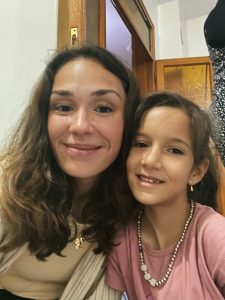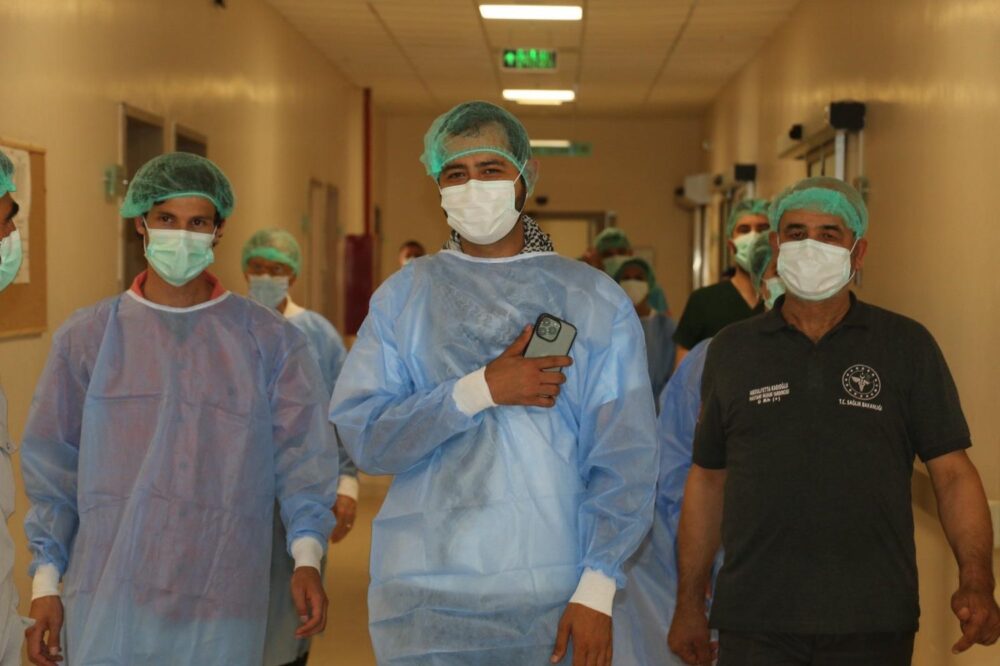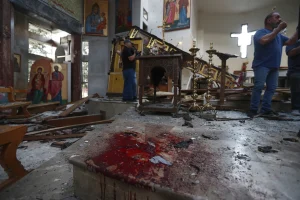I have not visited my home country in 12 years. When I think about Eastern Ghouta, I think about the swing my grandpa used to push me on as a 4-year-old- that Assad regime bombed and destoryed. If I were to visit today, I would only see ashes and dust. During the summertime in Damascus, I would walk the streets of Souq Al Hamidiyah, where I would get pistachio-dipped ice cream. If I were to visit today, I would only hear the Russian language spoken around me.


My memories of Syria were beautiful, but if I were to return home, I would immediately be arrested for my degree from a foreign University and my activism for the people of Syria. As a member of the Syrian Emergency Task Force, I had the opportunity to join the team’s bi-monthly trip to the border of Turkey and Syria, where we deliver essential aid to our humanitarian projects and meet with various NGOs working towards a free Syria.
Our team was accompanied by the wonderful M. Night Shyamalan Foundation who has been an advisor, friend, and supporter of SETF for years. When we arrived in Gaziantep, we first met with the Bahar organization. The team at Bahar works tirelessly to supply humanitarian aid to the Northern part of Syria and they assist us with aid delivery inside of Syria. They frequently visit our humanitarian projects in Turkey and in Syria and have become an essential component of our on-the-ground operations.

Our visit with Bahar was followed by a meeting with the Syrian Interim Government, where we were briefed of the situation in Gaziantep and on the ground in Syria. Our team continues to work closely with the Interim Government as they rebuild the liberated areas of Northern Syria.

Next was we visited the White Helmet headquarters. SETF has worked with the White Helmets for years, their heroism keeps the flame of the revolution alive. Our commitment to continue to collaborate with the White Helmets is strong.


Our next stop was at the House of Healing, SETF’s rehabilitation center which provides a safe place to live, warm meals, and transportation to and from medical appointments. Each patient is given special permission by the Turkish government to enter Turkey on a case-by-case basis. As SETF’s newest humanitarian project, the House of Healing will have it’s one year anniversary next month. Since the official adoption, our team has moved the project to a newer, four story building that can accommodate a larger number of people and offers more space for existing patients to heal and recover from the horrors of the war. A colorful playroom, a physical therapy room with equipment, a rooftop courtyard, separate floors for women and men, an adequate kitchen, and a front desk with security cameras all play into a more sustainable project that allows for a higher living standard for the patients themselves. There’s even a room specifically reserved for SETF team members when they visit for meetings or aid delivery. I had the honor of staying there for two nights while in Gaziantep.

Dr. Munir serves as the primary doctor at the House of Healing. He walked us through the house describing each patient’s case in great detail. Some patients had lost one or more of their limbs due to airstrikes hitting in close proximity to their homes. Others had kidney injuries, due to the lack of clean and safe water. A large amount of patients suffereed from eye injuries due to bombs exploding nearby. These patients were either waiting on corneal transplants or had already become blind. Other patients suffered from a cancer diagnosis due to the chemical toxins in the air from artillery. Although the adult patients in the house have exhibited the utmost bravery and strength in the eyes of destruction, meeting with the child patients brought emotion out of me that I have never experienced.
One young girl, Fatima , has a life threatening heart condition that has paused her growth and prevented her body from sustaining itself. She’s the same age as my little sister, Sham. They reminded me of eachother, both beautiful, kind, and full of life.
You expect these patients to have lost all hope. However, they laughed and played with us just as a friend or little sister would. No matter how severe their condition, the House of Healing was prepared to provide the best care possible for each patient that entered its doors.
The next day, I woke up prepared for another day of meetings. However, at the last minute, our executive director, Mouaz Mosutafa, told our group that we would be heading to a liberated city in the north of Syria, Aleppo. I had no words and my thoughts immediately raced back to the memories as a child in my beautiful Syria. Before I could even grasp the idea that I would be returning to my home country for the first time in 12 years, I was in a van on the way to the border.
Accompanied by Turkish forces throughout the trip, they ensured that our visit was as safe and secure as possible. Our first stop was the industrial city of Al-Rai. Al-Rai was overtaken by ISIS and then liberated, becoming a central industrial location supported by Turkish and free Syrian governments that have invested into rebuilding the area.

I had imagined all of the liberated areas to be nothing but rubble, just like the rest of the country. However, I soon remembered that Syrians are indestructible – they will rebuild. There were newly opened factories that provided jobs to the surrounding communities. The local council leaders expressed to us the internationally need to invest in these liberated areas in order to uplift these communities and grow opportunity for the local people.
There is a new, free Syria being rebuilt right in front of my eyes and I couldn’t believe it.
We then visited one of the eight local hospitals in the area. The local hospital in Al-Rai was brand new. It was 10,000 square meters with 24 clinics, 56 doctors, 42 specialists, 18 incubators, 9 on-call general doctors, and 4 dentists. The hospital offers general, neural, heart, digestive, and dialysis surgery and performs at least 15 surgeries a day. A medical school was soon to open in a new building on the campus.

Shortly after, our group visited a renovated three level secondary school that specialzies in science and technology. It was incredible to see a once-destroyed city being beautifully rebuilt with emphasis on education and opportunity.
Our next stop was Azaz, a city once destroyed by the regime but continues to be rebuilt. We visited on the anniversary of the city’s liberation from the regime and celebrations engulfed the city. The local council served us delicious lamb Mandi and we met with civilians who told us their stories of loss and destruction due to the brutality of the regime. They were so grateful that we were there to witness their testimonies and they asked us to share their message with the world.

“They wanted the world to know that they are not rebels nor extremists, there is many diverse group of people from different backgrounds, ethnicities, and religions that all live freely to work and rebuild their destructed city as one. They stayed in their homeland to do just this, despite continued attacks from the regime.”
Our next stop was at an internally displaced camp for orphans where we distributed envelopes of cash to children and families as a late Eid gift. The children also received letters of hope from around the world and their smiles and excitement to see us is something that I’ll never forget.

Our last stop was perhaps the most emotional for each of us – the Wisdom House. The Wisdom House was established in 2016 through grassroots support from American communities and the kindergarten serves as a school for orphans in Northwest Syria. The teachers and students are resilient, being displaced multiple times due to bombardment by the regime. Still, over 100 students have graduated from the Wisdom House each year for the last 6 years.
Our team is so deeply connected to the Wisdom House. We’ve received photos and videos of the students every day since it’s opening. We’ve sent thousands of letters of hope and school supplies needed for a healthy learning environment for 3-6 year olds who are traumatized by war. Our team can name the students and teachers and describe their personalities in a photo and we recognize the Letters of Hope and items we’ve sent them that decorate their classroom walls. We had never been given the opportunity to see it all in person – until today.

Entering the Wisdom House for the first time as a team was surreal. Tears of joy took over each team member and SETF’s Humanitarian Director who had worked tirelessly building up the Wisdom House for years from the U.S., Natalie Larrison, was speechless. Jerry Adams, an SETF board member and the co-founder of the Wisdom House was overwhelmed with joy. He never thought he would see with his own eyes the impact that his small community in Arkansas had made.
We shared laughs and snacks with the children and for the first time ever, we delivered letters of hope from around the world directly to their hands. Instead of seeing them in pictures, we could finally experience first hand the utmost joy and pride that these students and teachers had for their beloved school. Our team could not stop smiling the rest of the day, excited to share with the rest of the world what we had witnessed.
As we began to make our way out of Syria, I still hadn’t grasped that I was there in the first place. I was overwhelmed with emotions. I thought back to the swing in Eastern Ghouta where my grandfather would push as a 4-year-old and the streets of Damascus where I would get pistachio dipped ice cream on a hot summer day. These memories of my beautiful home have not disappeared.

After 12 years, I was reunited with my home. Bashar Al-Assad could wage war on millions of innocent civilians, but he could not stop me from crossing the border, breathing the Syrian air, and seeing my people in their land. For the first time I had witnessed the destruction that this monstrous regime continues to pursue against its own people. I saw families that resembled my own. Most importantly, I had witnessed the resilience of my people firsthand.
I was reminded of all the Syrians who wish to return but have been banned from their own country due to their opposition of the regime. I picked up a rock from the ground and put it in my pocket to be reminded of what Syria is to me. Syria to me is the natural urge to rebuild what has been destroyed, to have a resilient smile in the face of destruction, and the unmatched hope in your heart that one day, Syria will be free.









